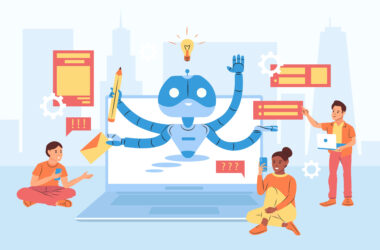Introduction
Understanding Generative AI in Translation
Generative AI in language translation is a game-changer in the world of communication. It employs advanced algorithms and neural networks to revolutionize how we interpret and convey messages across different languages and cultures.
At its core, Generative AI services enable AI-powered language translation that goes beyond simple word substitutions. It comprehends the contextual intricacies, idiomatic expressions, and cultural nuances that make language rich and dynamic. This deep understanding ensures accurate, meaningful, and culturally sensitive translations.
Ethical AI in translation is a critical component, ensuring that the power of Generative AI is harnessed responsibly and respects our world’s diverse linguistic and cultural landscapes. It’s not just about the future of language translation; it’s about the future of harmonious global communication.
Moreover, as AI for multilingual communication becomes increasingly prevalent, considerations like data privacy in AI translation must be addressed. Safeguarding sensitive information while facilitating seamless cross-language conversations is a complex but necessary aspect of this transformative technology.
In the ever-evolving realm of language translation, Generative AI is a beacon of innovation, offering a glimpse into a future where language is no longer a barrier but a bridge that unites us all.
Automating Translation Workflows
Generative AI is reshaping the translation landscape by streamlining and automating complex workflows. This revolutionary technology enhances efficiency while maintaining ethical standards.
Generative AI in translation leverages its deep understanding of languages and cultural contexts, significantly reducing the need for manual intervention. It speeds up the translation process, allowing for quicker multilingual content delivery.
Furthermore, as we venture into the future of language translation, AI plays a pivotal role in facilitating multilingual communication. Generative AI ensures that translations are rapid and maintain high accuracy levels, fostering effective global discourse.
While automating translation workflows, it is vital to address data privacy concerns. Ethical AI in translation ensures that sensitive information remains confidential and secure, thus safeguarding individuals’ privacy in an increasingly interconnected world.
Generative AI, with its ability to streamline and automate translation processes while upholding ethical standards and data privacy, is at the forefront of shaping the future of global communication.
Enhanced Translation Quality
The quality and accuracy of translations are dramatically improved using generative AI. It goes beyond simple word-for-word translations by considering context, colloquial expressions, and cultural nuances.
As a result, translations are produced that are grammatically, culturally, and contextually accurate. Generative AI develops its translation skills over time by continuously learning from enormous datasets.
It guarantees excellent translations thanks to its flexibility in adjusting to shifting linguistic nuances and trends. Generative AI thus raises the bar for translation accuracy, making it a crucial tool for successful cross-language communication and content localization.
Multilingual and Natural-Sounding Output
Generative AI is at the forefront of AI-powered language translation, revolutionizing the future of language translation with its ability to produce multilingual and natural-sounding output.
Ethical AI in translation ensures that this innovation is wielded responsibly, respecting diverse linguistic and cultural contexts while preserving data privacy in AI translation.
Generative AI’s multilingual capabilities stem from its deep understanding of languages and context. It seamlessly translates content across multiple languages, preserving the original message’s tone and intent. This fosters effective AI for multilingual communication, breaking down language barriers.
Moreover, Generative AI’s commitment to ethical standards means that translations remain culturally sensitive and respectful. It prioritizes data privacy, ensuring that sensitive information remains confidential in translation.
Generative AI’s ability to deliver multilingual, natural-sounding translations represents a remarkable stride in the future of language translation, enabling seamless, respectful, and secure cross-cultural communication.
Real-Time Translation Support
By providing real-time translation backing, generative AI has completely changed how we overcome language obstacles. Instant, accurate translations made possible by this ground-breaking technology make communication between languages simple and available in a variety of contexts.
Generative AI can simultaneously translate and transcribe spoken words in two languages in video conferencing and chat applications, enabling real-time communication between people around the world.
It enables visitors to travel around unfamiliar nations with ease by instantly translating menus, signs, and conversations. Additionally, it helps companies run multinational operations by removing language barriers in customer support and online shopping.
In addition to ensuring access to global knowledge, generative AI also broadens educational horizons and fosters cross-cultural exchange by instantly translating online content.
Understanding the Applications: Harnessing AI Across Industries
-
Healthcare: Bridging Language Barriers
Generative AI plays a crucial role in healthcare by addressing linguistic barriers. It allows patients and healthcare professionals who speak different languages to communicate easily.
Generative AI accurately translates medical information by having a strong awareness of context and complexity, protecting the validity of diagnosis and treatment strategies. This guarantees that patients, irrespective of their level of linguistic proficiency, receive the care they require.
Additionally, it promotes knowledge exchange amongst international healthcare professionals, boosting collaboration and increasing scientific investigation. The impact of generative AI on healthcare transcends language, enabling universal access to high-quality care.
-
E-commerce: Expanding Global Reach
Through accurate translation, generative AI enables e-commerce enterprises to grow internationally. It ensures that reviews, customer interactions, and product descriptions are faithfully translated so audiences worldwide may understand them.
In addition to drawing in a larger consumer base, this improved accessibility promotes customer happiness and trust. Generative AI allows e-commerce companies to flourish in various markets by removing linguistic barriers, increasing sales, and international expansion.
-
Legal: Ensuring Precision
By providing unprecedented precision, generative AI services are revolutionizing the field of legal document translation. Precision is crucial in the legal profession, and any misinterpretation could have serious repercussions.
The correct translation of legal papers while maintaining the intended legal meaning is made possible by generative AI’s profound knowledge of linguistic nuances. Beyond simple word-for-word translations, it understands the legal field’s context, jargon, and nuances.
Because of its accuracy, Generative AI is a priceless tool for legal practitioners in guaranteeing the integrity of documents regardless of language limitations. It not only saves time but also reduces potential legal concerns.
-
Entertainment: Subtitles and Dubbing
Generative AI has revolutionized the entertainment industry by offering seamless subtitle generation and dubbing for global content. It efficiently translates scripts, dialogues, and captions across languages while maintaining cultural nuances and lip-sync accuracy.
This enhances accessibility and enables a wider audience to enjoy films, TV shows, and other content in their preferred language.
Generative AI has become essential for content creators, ensuring their productions resonate with diverse audiences worldwide, breaking down language barriers, and fostering global entertainment consumption.
-
Technology: Real-Time Language Support
Technology firms can now offer unmatched real-time language support thanks to the revolutionary potential of generative AI, which ultimately raises user experiences to new heights.
Tech firms can instantly respond to user questions and concerns regardless of language by integrating AI-powered chatbots and language translation technologies into their goods and services.
This seamless multilingual communication increases operational efficiency by streamlining issue resolution and improving customer satisfaction. Additionally, it vastly expands a digital company’s worldwide reach, enabling it to access untapped areas and interact with a more diversified and international user base.
Generative AI is unique in understanding context and subtleties, ensuring that responses are correct and contextually relevant. It is an invaluable asset for digital organizations thanks to its precision and adaptability. It enables them to provide world-class customer service and forge lasting customer relationships, eventually fostering growth and innovation.
Overcoming Translation Challenges
-
Navigating Linguistic Nuances: The Art of Translation
The challenges of maintaining linguistic nuances while using Generative AI for translation are multifaceted. While AI-enhanced translation accuracy has made significant strides, it can sometimes overlook subtle linguistic intricacies essential for conveying the full meaning.
Cultural sensitivity in AI translation is another hurdle, as it requires understanding context, idioms, and cultural references that may have little equivalents in other languages.
Furthermore, AI-driven language learning and visionary AI translation aim to improve continuously, but these advancements often require substantial data and development. Achieving accessibility through AI translation, while crucial for bridging language gaps, must address linguistic diversity and regional variations.
Balancing these challenges is vital to harnessing the transformative potential of Generative AI for translation while ensuring that linguistic nuances and cultural subtleties remain intact in cross-language communication.
-
Cultural Sensitivity in AI: Bridging Language and Culture
AI-driven translations must be sensitive to cultural differences to ensure that communication crosses linguistic barriers without creating offense or misunderstanding. AI must comprehend each language’s cultural context, idioms, and nuances to provide correct and considerate translations.
Cultural insensitivity can lead to misunderstandings or even unintended rudeness, which can have serious repercussions in various situations, such as commercial negotiations, diplomacy, and social encounters.
AI-driven translations may bridge barriers between many cultures, enable meaningful global connections, and encourage tolerance by prioritizing cultural sensitivity, making them an essential component of contemporary language technology.
-
Ethical Considerations in Language and Translation Technologies
Considering ethical issues while using generative AI for language translation is vital. Concerns include data privacy, consent, and openness in handling sensitive information.
Furthermore, preserving cultural awareness and respecting linguistic variety is crucial to prevent biases or stereotypes from being perpetuated in translations. Making sure AI-driven translations adhere to moral standards encourages ethical and inclusive communication.
To fully utilize the capabilities of Generative AI for language translation while respecting the principles of fairness, respect, and privacy in an increasingly interconnected world, it is crucial to strike the correct balance between innovation and ethical practice.
-
Harmony in Human-AI Collaboration: The Future of Language
Precision and cultural appropriateness are crucial in the field of translation. The translation process has been automated and sped up thanks to generative artificial intelligence (AI). Still, its effectiveness shines when supplemented with human translators’ critical eye and cultural knowledge.
Human translators must refine AI-generated translations to the highest standards to be accurate. They provide:
- Their thorough comprehension of cultural nuances.
- Knowledge of the surrounding environment.
- Linguistic skills.
AI-generated translations are painstakingly reviewed and polished for grammatical correctness, cultural adequacy, and context relevance.
This harmonic interaction between AI and humans is key to ensuring the quality of translations. It blends the elegance and cultural sensitivity of human expertise with the speed and efficiency of AI.
It fills the gap between machine output and linguistic subtleties, ensuring message correctness while retaining cultural relevance—a prerequisite for effective cross-language communication.
The power of Generative AI and the mastery of human translators combine to produce accurate, contextually, and culturally appropriate translations, essentially combining the best of both worlds.
-
Data Privacy and Security in AI-Powered Language Solutions
The potential risks are highlighted by the very nature of storing and processing sensitive information through AI systems if appropriate security measures are not in place.
User data security is a top priority and an ethical need. It must be protected from potential breaches, illegal access, and misuse. This difficulty is further complicated by the need to ensure the secrecy of translations for sensitive or private information.
Finding the ideal balance between AI’s undeniable benefits and the necessity of strong data protection is the delicate task at hand.
In a time when data sensitivity is a growing concern, this balance is essential to establishing and maintaining user confidence and ensuring the ongoing integrity and dependability of language translation technology. It highlights the necessity for constant innovation and attention in AI to fulfill the needs of a world that is becoming more data-conscious.
Measuring Impact and Future Visions
A. Evaluating Translation Quality:
Evaluating the impact of Generative AI on translation quality is a multifaceted process that involves a range of methodologies:
- Quantitative Metrics: Automated metrics like BLEU, TER, and METEOR provide objective assessments by comparing AI-generated translations to human references. However, they may need to capture nuanced linguistic and cultural elements.
- Qualitative Assessment: Human evaluators analyze translations for fluency, coherence, and fidelity to source text meaning, offering insights into naturalness and cultural appropriateness.
- Human-AI Collaboration: Combining automated metrics with human evaluation ensures a more holistic evaluation, balancing objective metrics with human linguistic and cultural expertise.
- User Feedback: Continuous feedback allows for iterative improvements, helping AI systems align with user expectations and preferences and enhancing translation quality over time.
- Subjective Review: Expert linguists and domain specialists can provide in-depth assessments, particularly in specialized fields where precise terminology is crucial.
B. Future of Multilingual Communication:
With the help of generative AI, multilingual communication has a revolutionary future that will change how people engage and connect across linguistic barriers.
Here’s a hypothetical preview of what’s to come:
- Real-Time Multilingual Conversations: Real-time multilingual discussions will be possible thanks to voice assistants and chatbots powered by generative AI. These talks will seem natural and flow between speakers of many languages. This innovation will revolutionize healthcare, diplomacy, and customer service while promoting intercultural understanding.
- Accessibility of Digital Content Worldwide: Generative AI will increase the accessibility of digital content worldwide. To ensure people can access information and entertainment in their preferred language, websites, applications, and media platforms will leverage AI-driven translations to give material in many languages.
- Collaboration across cultures: In the corporate sector, generative AI promotes collaboration. Businesses will rely on AI-powered translation technologies to reduce language gaps and enable cross-regional collaboration. This will encourage innovation and broaden the worldwide market.
- Language Learning and Education: Generative AI will revolutionize language learning, offering personalized, immersive, and efficient language acquisition experiences. AI will create tailored learning paths, provide conversational practice, and assess language proficiency, making learning more accessible and effective.
- Ethical Considerations: As Generative AI becomes integral to multilingual communication, ethical considerations will play a crucial role. Ensuring transparency will be essential to responsibly harness the technology’s potential.
C. AI-Enabled Language Learning:
Massive potential exists for generative AI to transform language instruction and learning. This technology allows language learning sessions to be individualized, flexible, and immersive.
AI can customize learning routes, modifying activities, and courses to maximize the learning process by understanding the strengths and weaknesses of individual students.
Additionally, AI-driven chatbots and virtual language partners let students participate in actual conversations, enhancing their conversational proficiency and confidence in the language.
Through automated testing, AI can accurately evaluate a person’s linguistic abilities.
Overall, generative AI has the potential to increase the accessibility, engagement, and effectiveness of language learning by providing students with a dynamic and personalized educational experience that improves their linguistic proficiency and opens up opportunities for cross-cultural interaction and collaboration.
D. Ethical AI: Shaping the Future:
Ethical AI is poised to play a pivotal role in shaping the future of language translation by ensuring responsible and inclusive practices. As Generative AI continues to advance, ethical considerations become paramount.
Firstly, cultural sensitivity is essential. Ethical AI must understand the contextual intricacies, idiomatic expressions, and cultural nuances unique to languages, avoiding misinterpretations and misunderstandings.
Secondly, data privacy and security are critical. AI systems handling sensitive information during translation must implement robust measures to safeguard personal and confidential data, ensuring user trust and compliance with data protection regulations.
Thirdly, bias mitigation is imperative. Ethical AI must actively address and rectify biases present in training data to prevent discriminatory translations that could perpetuate stereotypes or stereotypes.
Lastly, transparency and accountability are vital. Users and stakeholders should have visibility into how AI translation models operate, ensuring that decisions are made transparently and ethically and fostering trust in AI-driven language translation.
E. Global Accessibility:
The impact of generative AI on economic dynamics in language translation goes far beyond the linguistic sphere. It can break down economic barriers by translating business and employment-related content.
Generative AI acts as a change agent in underdeveloped economies where language barriers restrict access to information and the global labor market. It empowers people with various career options, promoting economic growth and lowering inequities.
Additionally, there are several ways that generative AI can be used to assess translation quality. It combines qualitative assessments considering fluency, coherence, and cultural sensitivity with quantitative measures for objective assessment, such as BLEU and METEOR.
The joint synergy between humans and AI ensures a thorough evaluation process, guaranteeing that the quality of the translation is in line with both human expectations and quantitative benchmarks.
Looking ahead, a world where linguistic barriers vanish, and global contacts are made easier is the promise of the future of multilingual communication using Generative AI.
Generative AI’s transformative potential in language translation continues to be a driving force in creating the future of communication and connection, from real-time multilingual discussions to personalized language learning experiences, ethical considerations, and improved worldwide accessibility.
Conclusion
The blog demonstrates the disruptive potential of generative artificial intelligence in language translation and its broad impact on numerous facets of connectivity and communication. It highlights how translating business and employment-related material might create new economic opportunities by addressing regional economic differences.
Additionally, it emphasizes how crucial it is to check translation quality using quantitative measurements, qualitative evaluations, and human-AI collaboration to ensure that AI’s translations align with objective standards and people’s expectations.
The blog also makes predictions of multilingual communication, imagining a period when Generative AI enables cross-cultural collaboration, real-time dialogues, and immersive language acquisition. It emphasizes the value of ethical concerns, data privacy, cultural sensitivity, and bias reduction in the creation and application of AI translation technology.
In conclusion, Generative AI emerges as a disruptive force that eliminates linguistic boundaries and promotes a more interconnected world while improving language translation quality and influencing the future of communication, education, and global accessibility.
FAQ:
How accurate are AI-generated translations?
Although AI-generated translations have made great strides in accuracy, they could be better. Depending on the situation and language pairs, their performance varies.
Despite its straightforward and typical translation prowess, AI can still struggle with subtleties, colloquial idioms, and cultural nuances, making human review crucial for important text.
Can Generative AI handle complex language nuances?
To a certain extent, generative AI can manage subtle cultural and contextual nuances, but it may struggle with complicated linguistic nuance, necessitating human interaction for accurate and nuanced translations.
What industries benefit the most from AI-driven translation?
AI-driven translation significantly benefits e-commerce, tourism, and international trade because it facilitates effective communication with partners and customers worldwide, accelerates content localization, and improves user experiences.
How does Generative AI protect user data in translation?
Generative AI safeguards user data in translation by enacting privacy controls such as input anonymization, strong encryption, and local data processing when practical. Additionally, AI models can be programmed to delete private information after processing, guaranteeing that translations are secure and private.
What trends can we expect in AI translation in the coming years?
AI translation will likely see trends like improved contextual understanding, more language support, and enhanced real-time translation capabilities in the coming years.
Neural networks will continue to evolve, enabling better preservation of nuances, idioms, and cultural context, making translations increasingly indistinguishable from human-authored content.










